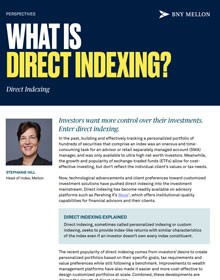What Is Direct Indexing?

What Is Direct Indexing?
NOV 06, 2023
STEPHANIE HILL
Head of Index | Mellon
Investors want more control over their investments. Enter direct indexing.
In the past, building and effectively tracking a personalized portfolio of hundreds of securities that comprise an index was an onerous and time-consuming task for an advisor or retail separately managed account (SMA) manager, and was only available to ultra-high net worth investors. Meanwhile, the growth and popularity of exchange-traded funds (ETFs) allow for cost-effective investing, but don’t reflect the individual client’s values or tax needs.
Now, technological advancements and client preferences towards customized investment solutions have pushed direct indexing into the investment mainstream. Direct indexing has become readily available on advisory platforms such as Pershing X’s Wove1, which offers institutional-quality capabilities for financial advisors and their clients.
DIRECT INDEXING EXPLAINED
Direct indexing, sometimes called personalized indexing or custom indexing, seeks to provide index-like returns with similar characteristics of the index even if an investor doesn’t own every index constituent.
The recent popularity of direct indexing comes from investors’ desire to create personalized portfolios based on their specific goals, tax requirements and value preferences while still following a benchmark. Improvements to wealth management platforms have also made it easier and more cost-effective to design customized portfolios at scale. Combined, these developments are driving the growth of direct indexing.
Getting Personal
Direct indexing, sometimes called personalized or custom indexing, uses optimization to systematically design a portfolio of individual securities based on an index such as the S&P 500® Index. The customized portfolio seeks to provide index-like returns with similar characteristics of the index even if the portfolio doesn’t contain every index constituent. In addition, it enables investors to own the actual securities that make up an index with an added benefit—personalized tax efficiency and flexibility. Financial advisors can shape direct indexing strategies to reflect the specific values and beliefs, or certain constraints of their clients, while continuing to pursue market gains from broad market exposure.
Although SMAs have been around for decades, direct indexing is now more accessible to a wider group of investors. Fees and investment minimums for direct indexing have come down.
Direct indexing assets are projected to rise at a five-year compound annual growth rate (CAGR) of 12.3% and close 2026 with an estimated $825 billion in total assets.2 The growth outlook for direct indexing is not surprising given that investors are increasingly seeking personalized investment solutions. Direct indexing provides advisors with options and a greater ability to meet their clients’ tax needs, customization and values-based investing needs.
Beyond Traditional Index Investing
Direct indexing SMAs offers benefits that are difficult to achieve through pooled investments such as mutual funds and exchange-traded funds (ETFs), including:
- the cost efficiency and ability to track an index
- an ability to customize, or tilt, portfolios based on investment objectives and factors such as value, momentum and minimal volatility
- the potential to improve after-tax returns and manage tax implications in a cost-effective manner through tax-loss harvesting, tax-gains harvesting and tax transitioning3,4
- a scaled solution designed to support financial advisors seeking to serve their clients in a tailored way
To elaborate on the preceding points, consider this scenario:
An investor with an investment position that is highly concentrated in one company would like to build an index-based portfolio around this stock to potentially reduce idiosyncratic risk. Or consider an investor who is restricted from holding his own company’s stock. That stock can be removed from their direct indexing portfolio. Their financial advisor could also use a direct indexing strategy to potentially diversify the portfolio in a tax-efficient way. ETFs typically are a more tax-efficient vehicle than mutual funds, but they cannot be personalized to an investor’s specific needs and tax situation. This scenario describes how direct indexing may help a financial advisor meet a client’s need for a personalized investment strategy and active tax management. Advisors can spend more time focusing on what their clients care about while the direct indexing provider handles the complex mechanics of optimization designed to search for the best tax alpha5 opportunities after taking into consideration real-world portfolio impacts, including wash sale rules, risk exposure and tracking to the index.
Direct indexing can be enhanced by the experience and technology of the solution’s provider. For example, BNY Mellon Precision Direct IndexingSM leverages Mellon’s 40 years of index management expertise and the power of Pershing X’s technology to provide advisors and clients with institutional-quality, personalized index solutions.6 Accessible in the Wove platform, the tax scenario planning tool enables financial advisors to create tax-optimized transitions, set tax budgets, monitor impacts on tracking error6 and generate client-ready analysis.
Invest in What’s Next
Direct indexing underscores the evolution of the financial industry. It is a strategy that may not be suitable for everyone but creates the potential to help investors meet their financial goals. Contact your relationship manager to find out more about BNY Mellon and Mellon’s indexing capabilities.
1 Clients must be appropriately contracted to use the Wove platform and all the associated services and tools including tax scenario planning tool.
2 The Case for Direct Indexing: Differentiation in a Competitive Marketplace, Cerulli Associates, December 2022.
3 Tax-loss harvesting is a process designed to reduce capital gains taxes owed from selling profitable investments. Tax-gain harvesting, as opposed to tax-loss harvesting, is a process of turning unrealized long-term capital gains into realized capital gains at a specific time for tax purposes. Tax transitioning is designed to spread out and help mitigate the tax consequences of the phased transitioning of an account to the target strategy over a period of time.
4 There’s no guarantee that a particular investor will realize significant tax benefits from harvesting gains or losses. Investment strategies that seek to employ tax management may be unable to fully realize strategic gains or harvest losses due to various factors. Market conditions and/or client account holdings may limit the ability to generate tax losses. Tax-loss harvesting involves the risks that the new investment could perform worse than the original investment and that transaction costs could offset the tax benefit. Also, a tax-managed strategy may cause a client portfolio to hold a security in order to achieve more favorable tax treatment or to sell a security in order to create tax losses. The ability to minimize tax consequences for a specific account may decrease as gains have the potential to accumulate over a period of time. Investors in lower tax brackets generally will not derive the same level of potential tax benefits from tax-managed strategies than those in higher tax brackets. Tax considerations, while important, are just one factor to consider before making any investment decision. Tax-managed investing and tax transitioning do not equate to comprehensive tax advice, are limited in scope and not designed to eliminate taxes in an account. Investors should contact their own tax advisor or financial professional for more detailed information on tax issues as they relate to an investor’s specific situation.
5 Tax alpha is the potential value generated by tax optimized solution based on the difference of excess pre-tax return and after-tax return.
6 As of October 2023, the only target index available is the S&P 500® Index
7 Tracking error, also referred to as “active risk,” indicates how closely a portfolio’s returns have followed the benchmark’s returns. A higher tracking error suggests the portfolio has deviated more from the benchmark while a lower tracking error suggests the portfolio is more similar to the benchmark.



